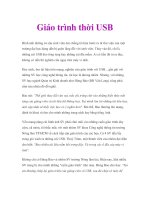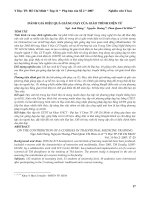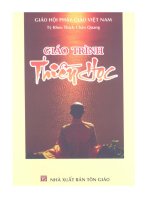Giáo trình ACNA - Chap07 pot
Bạn đang xem bản rút gọn của tài liệu. Xem và tải ngay bản đầy đủ của tài liệu tại đây (533.71 KB, 40 trang )
1
WORKING WITH
GROUPS
Chapter 7
Chapter 7: WORKING WITH GROUPS 2
CHAPTER OVERVIEW
•
Understand the functions of groups and how to
use them.
•
Understand the difference between local groups
and domain groups.
•
Identify the two group types and three group
scopes, and their proper use.
•
List the predefined and built-in groups included in
Windows Server 2003.
Chapter 7: WORKING WITH GROUPS 3
CHAPTER OVERVIEW (continued)
•
Understand the difference between groups and
special identities.
•
Create, manage, and delete groups using
graphical and command-line tools.
Chapter 7: WORKING WITH GROUPS 4
ACL AND SECURITY PRINCIPLES
•
Access control list restrict or permit access to
resource objects
•
Objects in the ACL are called security principles
•
Examples of security principles
•
User account
•
Computer account
•
Group
•
Printer
•
Shared folders
Chapter 7: WORKING WITH GROUPS 5
UNDERSTANDING GROUPS
Example:
Sales department resources
Shared folders = 3
Printers = 2
Users = 15
Per user permissions = 75
Group = 1 [Sales]
Group permission = 5
Chapter 7: WORKING WITH GROUPS 6
USING GROUPS AND GROUP POLICIES
•
Group policy and groups are not related.
•
Group policy cannot be directly applied to a group,
user and computer account object.
•
Group, user and computer account objects are
security principals.
•
Group policy is set on a site, domain, or OU
•
It can be configured to apply to groups in that site,
domain, or OU.
Chapter 7: WORKING WITH GROUPS 7
UNDERSTANDING DOMAIN FUNCTIONAL
LEVELS
•
Raising functional level action cannot be reversed
•
Domain functional levels
•
Windows 2000 mixed [default on install]
•
Windows 2000 native
•
Windows Server 2003 interim
•
Windows Server 2003
Windows 2000 mixed:
•
Windows NT4, Win2K and Win2K3 domain controllers.
•
Universal distribution groups but not universal security
groups.
•
Global groups cannot have other groups (group
nesting).
Windows 2003 native:
•
Windows 2K and Windows 2K3 domain controllers.
•
Universal distribution groups & universal security
groups.
•
Conversion between universal groups.
•
Migration security principals between DCs (SID
history).
Windows 2003 interim:
•
Windows NT4 Windows 2003 domain controllers.
•
Use for migration between NT4 and W2K3.
Windows 2003:
•
Windows 2003 domain controllers only.
•
Universal security and distribution groups.
•
Allows groups to be members of other groups.
•
Allows group conversions (security and distribution).
•
Allows migration of security principals from one
domain to another domain (SID history).
Chapter 7: WORKING WITH GROUPS 8
UNDERSTANDING DOMAIN FUNCTIONAL
LEVELS (continued)
•
Determines the level of functionality used by
Active Directory
•
Available levels depend on the operating system
servers are running
•
Some features are not available in certain levels
•
Functional level can be raised but not lowered
Chapter 7: WORKING WITH GROUPS 9
RAISING THE DOMAIN FUNCTIONAL LEVEL
•
Active Directory
Domains and Trusts
•
Right click
•
Do not raise at this
time
In addition to AD features, forest functional level allows
domain rename.
Chapter 7: WORKING WITH GROUPS 10
USING LOCAL GROUPS
•
Can be used only on the system on which they are
created
•
In a workgroup environment, can contain only
users from the local system
•
In a domain environment, can contain users and
global groups
•
Cannot be created on a domain controller
Chapter 7: WORKING WITH GROUPS 11
USING ACTIVE DIRECTORY GROUPS
•
Group Types
•
Security
•
Distribution
•
Group Scopes
•
Local
•
Global
•
Universal
Detail discussion on slides that follow
Chapter 7: WORKING WITH GROUPS 12
GROUP TYPE: SECURITY GROUPS
•
Used to assign access permissions for network
resources.
•
Membership depends on the type of security
group and the domain functional level.
•
Can also be used as a distribution group.
•
The most common type of group created and used
in Active Directory.
Chapter 7: WORKING WITH GROUPS 13
GROUP TYPE: DISTRIBUTION GROUPS
•
Cannot be used as security principals to grant
permission to objects
•
List of IDs used to group users together for use by
applications in non-security-related functions
•
Can be used only by directory-aware applications
such as Microsoft Exchange
•
Can be converted to a security group
•
Security group can be used as distribution group,
so distribution group may not be used
Chapter 7: WORKING WITH GROUPS 14
GROUP SCOPES
•
Domain local groups
•
Most often used to assign access permission to resources
either directly or adding a global group to a domain local
group.
•
Global groups
•
Used primarily to provide categorized membership in domain
local groups for individual security principals or for direct
permission assignment.
•
Used to collect users or computers in the same domain that
share the same job, role or function or that have similar
network access requirements.
•
Universal groups
•
Used primarily to grant access to resources in multiple
domains.
Chapter 7: WORKING WITH GROUPS 15
GROUP SCOPE: DOMAIN LOCAL GROUPS
•
Available in all domain functional levels
•
Can only be used to assign permissions to resources in
the domain where they are created
•
Membership depends on domain functional level
•
W2K mixed or W2K3 interim can include
•
User and computer accounts, and global groups from any
domain in forest
•
No other group nesting
•
W2K native or W2K3 can include
•
User and computer accounts, global and universal groups from
any domain in forest.
•
Can convert to universal scope if contains no domain local
groups as members.
Chapter 7: WORKING WITH GROUPS 16
GROUP SCOPE: GLOBAL GROUPS
•
Available in all functional levels
•
Can be converted to universal group as long as it is not a
member of any other global group
•
Can be member of machine local or domain local groups
•
Can only include members from within their domain
•
Membership depends on domain functional level
•
W2K native or W2K3 global group members can include user
and computer account, and other global groups from the
same domain
•
W2K mixed user and computer account from the same
domain
•
Can be granted access permissions to resources in any
domain in the forest, and in domains in other trusted
forests
Chapter 7: WORKING WITH GROUPS 17
GROUP SCOPE: UNIVERSAL GROUPS
•
Available only in the Windows 2000 native and Windows
Server 2003 domain functional levels
•
Can include user and computer accounts, global groups,
and other universal group from any domain in the forest
•
Can be granted access permissions for resources in any
domain in the forest, and in domains in other trusted
forests
•
Can be converted to domain local groups or to global
groups, as long as they do not have other universal groups
as members
•
Generally used to consolidate groups that span multiple
domains
Chapter 7: WORKING WITH GROUPS 18
NESTING GROUPS
M
M
e
e
m
m
b
b
e
e
r
r
s
s
A
A
l
l
l
l
o
o
w
w
e
e
d
d
i
i
n
n
W
W
i
i
n
n
d
d
o
o
w
w
s
s
2
2
0
0
0
0
0
0
M
M
i
i
x
x
e
e
d
d
o
o
r
r
W
W
i
i
n
n
d
d
o
o
w
w
s
s
S
S
e
e
r
r
v
v
e
e
r
r
2
2
0
0
0
0
3
3
I
I
n
n
t
t
e
e
r
r
i
i
m
m
F
F
u
u
n
n
c
c
t
t
i
i
o
o
n
n
a
a
l
l
L
L
e
e
v
v
e
e
l
l
M
M
e
e
m
m
b
b
e
e
r
r
s
s
A
A
l
l
l
l
o
o
w
w
e
e
d
d
i
i
n
n
W
W
i
i
n
n
d
d
o
o
w
w
s
s
2
2
0
0
0
0
0
0
N
N
a
a
t
t
i
i
v
v
e
e
o
o
r
r
W
W
i
i
n
n
d
d
o
o
w
w
s
s
S
S
e
e
r
r
v
v
e
e
r
r
2
2
0
0
0
0
3
3
F
F
u
u
n
n
c
c
t
t
i
i
o
o
n
n
a
a
l
l
L
L
e
e
v
v
e
e
l
l
Domain
Local
User and computer accounts
and global groups from
any domain
User and computer accounts,
universal groups, and global groups
from any domain; other domain
local groups from the same domain
Global User and computer accounts
from the same domain
User and computer accounts and
other global groups from the same
domain
Universal Not available User and computer accounts, other
universal groups, and global groups
from any domain
G
G
r
r
o
o
u
u
p
p
S
S
c
c
o
o
p
p
e
e
Chapter 7: WORKING WITH GROUPS 19
CONVERTING GROUPS
T
T
o
o
D
D
o
o
m
m
a
a
i
i
n
n
L
L
o
o
c
c
a
a
l
l
T
T
o
o
G
G
l
l
o
o
b
b
a
a
l
l
T
T
o
o
U
U
n
n
i
i
v
v
e
e
r
r
s
s
a
a
l
l
F
F
r
r
o
o
m
m
D
D
o
o
m
m
a
a
i
i
n
n
L
L
o
o
c
c
a
a
l
l
Not applicable Not permitted Permitted only when the
domain local group does not
have other domain local
groups as members
F
F
r
r
o
o
m
m
G
G
l
l
o
o
b
b
a
a
l
l
Not permitted Not applicable Permitted only when the
global group is not a member
of another global group
F
F
r
r
o
o
m
m
U
U
n
n
i
i
v
v
e
e
r
r
s
s
a
a
l
l
No restrictions Permitted only when
the universal group
does not have other
universal groups as
members
Not applicable
You may need to convert groups… What you can do…
Chapter 7: WORKING WITH GROUPS 20
PLANNING GLOBAL AND DOMAIN LOCAL
GROUPS
•
Step 1—Create domain local groups for resources
to be shared.
•
Step 2—Assign resource permissions to the
domain local group.
•
Step 3—Create global groups for users with
common job responsibilities.
•
Step 4—Add global groups that need access to
resources to the appropriate domain local group.
Best Practices…
Chapter 7: WORKING WITH GROUPS 21
WINDOWS SERVER 2003 DEFAULT GROUPS
•
Built-in local groups
•
Predefined Active Directory groups
•
Built-in Active Directory groups
•
Special identities
Refer to your textbook for the list…
Chapter 7: WORKING WITH GROUPS 22
BUILT-IN LOCAL GROUPS
Chapter 7: WORKING WITH GROUPS 23
PREDEFINED ACTIVE DIRECTORY GROUPS
Enterprise & Schema Admins appear in the first forest DC
Chapter 7: WORKING WITH GROUPS 24
BUILT-IN ACTIVE DIRECTORY GROUPS
Chapter 7: WORKING WITH GROUPS 25
SPECIAL IDENTITIES
•
Member cannot be
added directly but by
action or access –
Example: Authenticated
Users









